EVs have a partisanship problem in America. Here’s how we can fix that.
Source: Electric Vehicle News
What Are The Different Types of EV Chargers?
EV chargers fall into three categories based on their charging speed: Level 1, Level 2, and Level 3. Here’s how they differ.
Source: Electric Vehicle News
Fisker Ocean OTA Update Brings Brake Disk Wiping But ACC Is Still Missing
Ocean OS 2.0 will begin rolling out to Fisker’s EV next week.
Source: Electric Vehicle News
Choice Hotels Across The U.S. Will Install Universal Chargers For EV Drivers
Hotel brands like Radisson, Cambria, and Comfort can add four or more Tesla Wall Chargers for guests, according to the deal.
Source: Electric Vehicle News
Range Energy’s electrified semi-trailer now eligible for up to $120,000 incentive through California’s CORE Project
Range Energy makes electrified semi-trailers for the heavy-duty freight market. Range’s trailer, which is equipped with a battery pack (up to 300 kWh), an electric motor and (as a bonus) off-road mobile power, can be used with any semi-tractor, and the company says it can double the fuel mileage of a diesel rig while cutting NOx emissions by 67 percent.
Now the California Air Resources Board (CARB) has increased the point-of-sale incentive value for Range’s 53-foot electric trailer, the RA, from $80,000 to up to $120,000 per unit, through the Clean Off-Road Equipment (CORE) Voucher Project.

CORE provides a streamlined voucher process by which California fleet owners and operators can receive funding to offset the cost of cleaner vehicles and off-road equipment. The CORE voucher program now covers Range’s full product lineup.
“Becoming eligible for CORE proved that trailers truly matter in the transition to electric, and that CARB recognizes the meaningful impact electric-powered trailers can have on reducing the emissions of the commercial trucking sector,” said Ali Javidan, founder and CEO of Range. “Increasing our trailer platform’s incentive value by $40,000 further solidifies that position, and makes Range a realistic near-term solution for fleet owners and operators to deploy zero-emissions equipment.”
Source: Range Energy
Source: Electric Vehicles Magazine
The Mobility House to lead project to provide electric school bus bidirectional charging infrastructure
The Clean Transportation Program of the California Energy Commission (CEC) has awarded a $2.9-million grant to a project team led by California V2G technology company The Mobility House for the installation of 12 bidirectional chargers at four California schools in the Pittsburg, Fremont and Napa unified school districts.
The Replicable V2X Deployment for Schools (RVXDS) project is designed to use school bus fleets to reduce regional grid stresses. Open standards are used throughout the vehicles, hardware and software. Three of the school districts will export power from buses during summertime peak periods, earning $2 per kWh through the Emergency Load Reduction Program (ELRP). One school district will use bidirectional functionality for V2B, acting as a community resilience hub at the high school. Results of the project will be issued in a blueprint report to provide V2G guidance to districts across the state.
The Mobility House has recruited project partners that include World Resources Institute, the Center for Transportation and the Environment, and Polara Energy USA.
“Our interest is to establish real-world examples of V2G projects that other districts can easily replicate,” said Greg Hintler, CEO of North America at The Mobility House.
Source: Mobility House
Source: Electric Vehicles Magazine
CSL and Adbri to build battery-capable self-unloading ship
Canadian dry bulk carrier operator CSL has entered into a long-term partnership with Australian cement manufacturer Adbri (formerly Adelaide Brighton Cement) to build and operate a “battery-capable” self-unloading vessel. Construction will commence in 2024, and delivery is expected in early 2026.
The 11,000 DWT ship was designed to support the company’s limestone operations in South Australia. It will replace Adbri’s Accolade II and will carry up to 3 million tons of limestone annually, a 35% increase over current capacity.
Approximately 50% of the vessel’s energy requirements will be provided by a combination of shore power and battery energy storage, and the company plans to install sufficient batteries in the future to allow 100% electric operations.
“The vessel will initially run on a hybrid diesel and battery system, replacing 25% of diesel with electric power and lowering Scope 1 emissions by 40% compared to Accolade II,” explained CSL President and CEO Louis Martel. “By 2031, we aim to run the ship entirely on electric power, further reducing Scope 1 emissions to less than 10%.”
Source: CSL
Source: Electric Vehicles Magazine
Swiss cement supplier Holcim to order 1,000 Mercedes-Benz eActros 600 electric trucks
Swiss building materials producer Holcim has signed a joint letter of intent with Mercedes-Benz Trucks to purchase 1,000 eActros 600 electric trucks, the majority of which will be used with silo trailers for transporting building materials, including cement.
It is the largest planned single order to date for the eActros 600. Around 50 prototype models are being built in advance of the next step of practical customer testing. Series production is expected to begin at the end of 2024.
Mercedes-Benz claims a range of 500 km for the eActros 600. The truck has a battery capacity of 600 kWh, and can use CCS charging at speeds of up to 400 kW. Megawatt Charging System (MCS) support will be retrofitted when the technology becomes available.
“Holcim is advancing the transition to more sustainable and efficient transportation by decarbonizing our operations’ logistics. We are excited to be partnering with Mercedes-Benz Trucks to electrify our fleet,” said Miljan Gutovic, Region Head Europe at Holcim.
Source: Daimler
Source: Electric Vehicles Magazine
Tesla Increased China-Made EV Wholesale Sales In January 2024
The Shanghai factory achieved its best January ever.
Source: Electric Vehicle News
New survey finds myths and misinformation about EVs are deeply embedded
It won’t be news to regular Charged readers that myths and misconceptions about EVs have taken deep root among the populace. When I tell a new acquaintance that I write about EVs, as often as not their reply is some sound bite that could be a direct quote from an oil industry social media feed.
Electrify Research has put some numbers to the nonsense. The firm recently surveyed homeowners in the US, the UK, France and Germany, and discovered that myths and misinformation about EVs (and heat pumps) have penetrated deep into the public consciousness in all four countries.
Electrify Research’s Home Electrification Tracker Survey polled roughly 1,000 people in each of the four countries in October 2023. All respondents were homeowners over 18, and they represented a variety of ages, genders and regions.
Of the myths tested, the one with the most widespread buy-in was: “Mass adoption of EVs swaps one problem (pollution from oil and gas) with another (lithium and cobalt mining, dead batteries).” Overall, 62% of respondents either agreed (33%) or agreed strongly (29%) with this statement. In fact, although there are indeed environmental and social problems associated with battery production, many scientific studies have demonstrated that the environmental footprint of EVs pales in comparison to that of fossil fuel extraction. (See recent articles in The Guardian, the New York Times, et al.)
The myth with the second-highest level of acceptance: “The batteries in EVs make them a serious fire hazard.” In Electrify’s survey, 72% of respondents in Germany reported believing in this one, as did 46% in the UK. In fact, although battery fires often look spectacular, and are notoriously hard to put out, the research shows that ICE vehicles are many times more likely to catch fire in the first place. (See a recent article in The Conversation, which includes links to numerous scientific studies.)
The third most widely held false belief: “The electricity grid won’t be able to cope with the demands of mass EV adoption.” Some 61% of German respondents, and 50% of Brits, fell for this one. Again, there’s a grain of truth here, but only a grain. Upgrades to electrical girds are sorely needed, especially in the US (and not only because of EVs). But Charged regularly speaks with execs at electric utilities, as well as companies that provide charging management software, and while all acknowledge the challenges, to date none has expressed any concern about EVs “crashing the grid.”
One myth that isn’t a myth: “Public chargers for EVs are unreliable and often out of order.” Between 42% and 53% of respondents agreed with this statement, and we won’t contradict them. The unreliability of public chargers is a very frequent topic at Charged and every other EV-related media outlet. The good news is that everyone in the industry is well aware of the problems, and improvements on several fronts (standardized error codes, new reliability standards, improved reporting and maintenance) are in the works. Federal programs that fund public charging include uptime requirements, so charging providers will soon be forced to raise their games. Further good news: the majority of charging takes place at home, and home chargers are by all accounts extremely reliable. Unless you live somewhere where you can’t install a charger, or take frequent long road trips, you’ll probably never need to visit a public charging station.
The Electrify Research survey found that susceptibility to anti-EV myths varied across certain demographic categories. Unsurprisingly, respondents who say they’re concerned about climate change are less prone to believing the myths. Also not so surprising is the fact that males consistently showed a higher likelihood of believing the bull compared to females.
Source: Electrify Research
Source: Electric Vehicles Magazine






